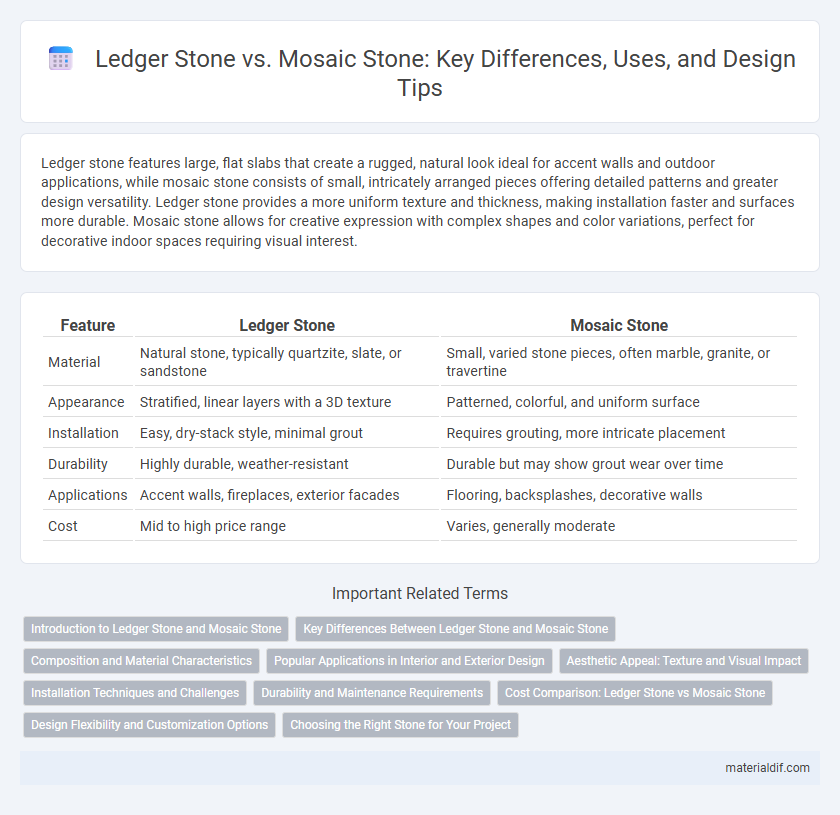Ledger stone features large, flat slabs that create a rugged, natural look ideal for accent walls and outdoor applications, while mosaic stone consists of small, intricately arranged pieces offering detailed patterns and greater design versatility. Ledger stone provides a more uniform texture and thickness, making installation faster and surfaces more durable. Mosaic stone allows for creative expression with complex shapes and color variations, perfect for decorative indoor spaces requiring visual interest.
Table of Comparison
| Feature | Ledger Stone | Mosaic Stone |
|---|---|---|
| Material | Natural stone, typically quartzite, slate, or sandstone | Small, varied stone pieces, often marble, granite, or travertine |
| Appearance | Stratified, linear layers with a 3D texture | Patterned, colorful, and uniform surface |
| Installation | Easy, dry-stack style, minimal grout | Requires grouting, more intricate placement |
| Durability | Highly durable, weather-resistant | Durable but may show grout wear over time |
| Applications | Accent walls, fireplaces, exterior facades | Flooring, backsplashes, decorative walls |
| Cost | Mid to high price range | Varies, generally moderate |
Introduction to Ledger Stone and Mosaic Stone
Ledger stone features thin, natural stone pieces arranged in a staggered, linear pattern for a textured, rustic appearance ideal for accent walls and fireplaces. Mosaic stone consists of small, uniformly cut stone tiles assembled into intricate patterns or images, offering versatile design options for backsplashes and flooring. Both materials enhance architectural aesthetics but differ in installation methods, surface texture, and visual impact.
Key Differences Between Ledger Stone and Mosaic Stone
Ledger stone consists of long, narrow slabs designed for wall cladding, providing a natural, stacked appearance with distinct linear patterns. Mosaic stone features small, uniformly sized pieces arranged in intricate patterns or designs, ideal for decorative flooring or backsplashes with a smooth, detailed texture. Key differences include size and application, with ledger stone offering rugged, dimensional surfaces and mosaic stone emphasizing artistic flexibility and detailed visual effects.
Composition and Material Characteristics
Ledger stone is typically composed of natural stone slabs such as slate, quartzite, or sandstone, characterized by its rough, textured surface and layered appearance. Mosaic stone, on the other hand, consists of small cut pieces of various stones like marble, granite, or glass, arranged in intricate patterns with a smoother, polished finish. The material properties of ledger stone make it durable and slip-resistant, suitable for exterior cladding, while mosaic stone offers aesthetic versatility and decorative detail ideal for interior applications.
Popular Applications in Interior and Exterior Design
Ledger stone is widely used in exterior applications such as accent walls, fireplaces, and facades due to its textured, linear appearance that adds depth and natural appeal. Mosaic stone, favored for interior design, enhances backsplashes, flooring, and shower walls with its intricate patterns and vibrant color variations, creating a sophisticated focal point. Both materials offer durable, visually striking solutions, with ledger stone excelling in rugged outdoor environments and mosaic stone delivering detailed artistry indoors.
Aesthetic Appeal: Texture and Visual Impact
Ledger stone features a rugged, three-dimensional texture that creates a bold, natural aesthetic ideal for accent walls and exterior facades. Mosaic stone offers a smoother, more uniform surface with intricate patterns, providing a refined and elegant visual impact suitable for indoor settings. The choice between ledger and mosaic stone depends on the desired depth and complexity of texture to enhance architectural design.
Installation Techniques and Challenges
Ledger stone installation involves stacking thin, rectangular pieces directly onto a prepared surface, requiring precise alignment and minimal grout lines for a natural, layered appearance. Mosaic stone installation uses small, often intricately patterned pieces set on mesh backing, necessitating careful handling to maintain design continuity and proper adhesion over complex surfaces. Both methods demand expertise to address challenges such as surface preparation, moisture management, and ensuring durable bonding for long-lasting results.
Durability and Maintenance Requirements
Ledger stone offers superior durability due to its dense, natural composition, making it highly resistant to cracks and chips in both interior and exterior applications. Mosaic stone, composed of smaller, thin-cut pieces, requires more frequent maintenance to address grout cleaning and potential loosening over time. Choosing ledger stone minimizes upkeep and ensures long-lasting structural integrity in high-traffic areas.
Cost Comparison: Ledger Stone vs Mosaic Stone
Ledger stone typically costs between $10 and $30 per square foot, offering an affordable yet durable option for wall cladding. Mosaic stone, with its intricate patterns and smaller pieces, ranges from $20 to $50 per square foot, reflecting higher labor and material expenses. Choosing between ledger and mosaic stone depends largely on budget constraints and desired aesthetic impact.
Design Flexibility and Customization Options
Ledger stone offers superior design flexibility with its ability to create textured, layered wall surfaces that can be arranged in various patterns, making it ideal for accent walls and architectural features. Mosaic stone provides extensive customization options through its smaller, interlocking pieces that allow intricate designs, color variations, and personalized layouts suitable for backsplashes, countertops, and flooring. Both types of stone enhance aesthetic appeal but cater to different design needs: ledger stone excels in bold, rugged textures while mosaic stone supports detailed, artistic expressions.
Choosing the Right Stone for Your Project
Ledger stone offers a natural, textured surface ideal for accent walls and exterior applications, providing durability and a rustic aesthetic. Mosaic stone, composed of smaller, often polished pieces, is perfect for intricate designs and indoor decorative features, delivering versatility and fine detail. Choosing between ledger and mosaic stone depends on the project's visual goals, installation environment, and maintenance requirements to ensure optimal performance and style.
Ledger Stone vs Mosaic Stone Infographic

 materialdif.com
materialdif.com